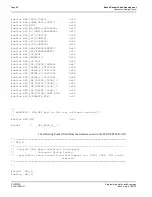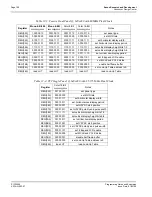
Page 94
Epson Research and Development
Vancouver Design Center
S1D13505
Programming Notes and Examples
X23A-G-003-07
Issue Date: 01/02/05
** Draw a 100x100 red rectangle in the upper left corner (0, 0)
** of the display.
*/
pMem = DISP_MEM_OFFSET;
for (y = 0; y < 100; y++)
{
pTmp = pMem + y * 640L;
for (x = 0; x < 100; x++)
{
*pTmp = 0x0c;
pTmp++;
}
}
/*
** Init the HW cursor. In this example the cursor memory will be located
** immediately after display memory. Why here? Because it's an easy
** location to calculate and will not interfere with the half frame buffer.
** Additionally, the HW cursor can be turned into an ink layer quite
** easily from this location.
*/
*(pRegs + 0x30) = CURSOR_START;
pTmp = pCursor = pMem + (DISP_MEMORY_SIZE - (CURSOR_START * 8192L));
/*
** Set the contents of the cursor memory such that the cursor
** is transparent. To do so, write a 10101010b pattern in each byte.
** The cursor is 2 bpp so a 64x64 cursor requires
** 64/4 * 64 = 1024 bytes of memory.
*/
for (lpCnt = 0; lpCnt < 1024; lpCnt++)
{
*pTmp = 0xAA;
pTmp++;
}
/*
** Set the first user definable cursor color to black and
** the second user definable cursor color to white.
*/
*(pRegs + 0x2C) = 0;
*(pRegs + 0x2D) = 0;
*(pRegs + 0x2E) = 0xFF;
*(pRegs + 0x2F) = 0xFF;
/*
** Draw a hollow rectangle around the cursor.
*/
pTmp = pCursor;
for (lpCnt = 0; lpCnt < 16; lpCnt++)
{
*pTmp = 0x55;
pTmp++;
















































